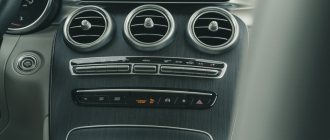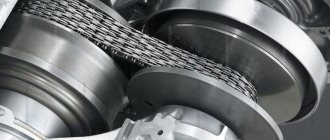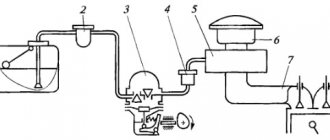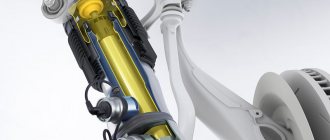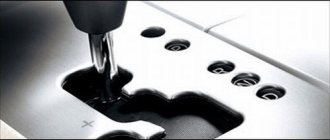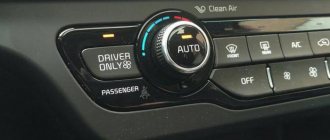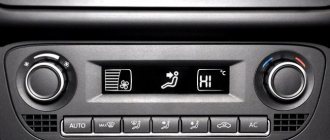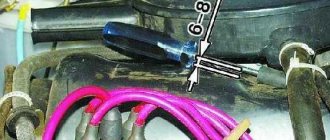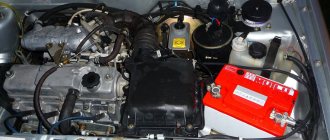Good afternoon to all my readers, today I’ll tell you about climate control in a car, what it is and how to use it. How does it differ from a simple car air conditioner, how to turn it on and configure it. Having climate control in your car and not using it because you don’t know how or it’s blowing in the wrong direction is stupid, isn’t it? So let's figure it out and use it.
Why is this system in the car?
This system in the car should provide comfort in the car interior for the driver and passengers. It differs from a simple air conditioner in that it is capable of maintaining the conditions set by the driver, and not just blowing air. Climate control in the car interior ensures thermal comfort for the driver and passengers.
The CC system consists of an air conditioner, a heater, humidity and temperature sensors, a filter system and a computer control unit. It maintains the microclimate inside the cabin, regardless of the street weather.
Self-diagnosis procedure
This function is available if the climate control on the Camry 40 is equipped with a unit with an LCD display. On older versions of units, diagnostics can only be carried out using a car scanner by connecting to the standard connector located near the steering column.
Self-diagnosis procedure
We are trying to carry out self-diagnosis of the climate systems in the car, you need to perform the following steps:
- Turn off the engine, turn off the ignition.
- Simultaneously press the Auto button on the climate control panel and the button that activates internal air circulation.
- While holding the buttons, turn on the ignition. At the same time, all indicators located on the remote control display will begin to blink, which indicates the start of the self-diagnosis process.
- After checking the display and diagnostics of the sensors, an error code will be displayed on the display in the place where the temperature is normally displayed.
- If 2 or more errors occur, they are displayed alternately, starting with the smallest code.
The climate control on the Toyota Camry is equipped with a considerable number of electric drives, the functionality of which can be checked by switching to self-diagnosis mode. To do this you need:
- Start the system self-diagnosis process as described above, then press the button that activates air circulation inside the cabin. Important: diagnostics must be performed on a fully warmed-up internal combustion engine.
- During the test, various fan operating modes will turn on alternately, with a delay of 1 second, and the dampers will open/close.
- You can increase the interval for changing modes by pressing the windshield defogger button.
- To exit the test mode for drives, relays and fans, press the AUTO button - in this case, the control unit will switch to the sensor test mode.
The diagnosis is completed by pressing the Off button.
Climate control for Toyota Camry
The climate control control unit on the Toyota Camry supports the memory clearing function. It should be carried out after eliminating errors that arose during the self-diagnosis process. It is performed as follows:
- The control unit is put into diagnostic mode.
- Press the front window heating and rear window heating buttons at the same time.
- The error memory has been cleared.
There are many reasons why the climate control on a Camry 50 or 40 shows errors during self-diagnosis: from missing contact to sensor failure.
Possible malfunctions that occur during climate control operation are as follows:
- sensor malfunction. Fixed by replacing it;
- control unit malfunction. Often, to fix the problem, it is enough to simply disassemble it and solder all the contacts;
- Damaged electrical wiring or sensor connectors. This often occurs as a result of unqualified intervention in the electrical equipment of a car;
- weak compressor drive belt tension or damage. In this case, you need to check the integrity of the belt;
- failure of the electromagnetic clutch sensor installed in the compressor;
- compressor failure or blockage;
- leakage or lack of refrigerant, or its level does not correspond to that established by the car manufacturer;
- lack of contact with the instrument panel or engine ECU.
It is also worth noting that the climate control on Camry 40 or 50 must be diagnosed in a well-lit room or outdoors - otherwise a light sensor error may occur.
Principle of operation
The device is based on a processor that controls the temperature and humidity in the car using many sensors. The owner selects the desired climate parameters by pressing the control unit buttons.
The processor, based on these parameters, regulates and maintains the temperature, focusing on the sensors, turns on the heating or cooling systems, and controls their operation. The climate control includes a heater, which allows you to heat the interior of the car in winter.
In addition, it can dry the air passing through it. Dehumidification prevents your car windows from fogging up. More modern systems are also able to take into account the solar effect on the temperature inside the car. The system has an ultraviolet ray sensor. Another useful climate control function is the recirculation of air inside the cabin if the outside air is polluted with dust, smoke or unpleasant odors.
Recirculation is automatically ensured by processor control of the filter system. When air pollution begins to exceed the norm, then the climate control stops taking air from outside and begins to repeatedly circulate the air that is inside the car. This happens automatically, without driver intervention.
How to properly use climate control in a car in summer
The operation of climate control in summer has the following features:
- The temperature should not be set less than 10 degrees from the external environment. Such a strong temperature difference can cause serious illness due to hypothermia.
- Before turning on this system, be sure to ventilate the interior. This work significantly lowers the air temperature and speeds up the cooling process of the air flow.
- To speed up the air cooling process, you need to turn on the air recirculation mode.
- You cannot open the sunroof or car windows while the system is operating. This may cause the sensors to receive erroneous information.
Types and features
By type, climate control systems are divided into subtypes. I'll start with the differences in the number of zones served by the system. Today there are systems serving from one driver’s zone and up to four zones, including all passenger seats:
- The simplest system controls one zone and includes only the driver and front passenger zones. I described how control occurs a little higher.
- The two-zone system allows you to set different parameters for the driver and front passenger zones.
- Accordingly, the remaining systems allow you to adjust the climate for rear seat passengers as well; the three-zone system has a common climate setting for both, while the four-zone system has a separate climate setting.
- The option with four zones is the most comfortable.
How to turn on the air conditioning if there is a child in the car
Anyone needs some time to adapt if they start using air conditioning regularly in the summer. This is especially pronounced in children, so they must be gradually accustomed to frequent appearances in refrigerated cabins.
The same rules for using climate control must be followed, but in relation to children this requires an even more gradual approach and precise control over flows:
- You cannot start immediately with the temperature regime that is most preferable for adults. If there are children in the car, the temperature is initially set a couple of degrees higher, lowering it as they get used to it;
- Low humidity, characteristic of a working cooler, is just as harmful to a child as high humidity, a doctor can tell you how to deal with this by prescribing simple pharmaceutical products, amateur activities, as well as technical advice, are undesirable here;
- Not only should the deflectors not be directed at the child, but it is also advisable to set the fan speed to a minimum;
- The evaporator must be cleaned and disinfected more often.
It is advisable to work with children to ensure that they are not allowed to interfere with the system control panel or change settings on their own.
Differences from air conditioning
The air conditioner may not have a heating function, and if it does, the driver has to adjust the temperature manually. This is not always convenient. Climate control constantly monitors the temperature, thanks to sensors, and regulates heating and cooling itself.
The simplest climate control with one zone has the following air supply modes:
- To the head department
- To your feet
- And there and there (head/legs)
- Legs and windshield
The air flowing onto the glass is dried to prevent fogging. More multi-zone systems distribute the direction of air within the cabin more widely.
Device
Climate control systems are distinguished by the presence of a different number of zones. Regarding the number of zones, such a device can be: 1-zone, 2-zone, 3-zone and 4-zone.
The climate control system contains components of heating, ventilation and air conditioning structures. Their series also includes a stove radiator, an inlet air fan and an air conditioning device, which includes an evaporator, compressor, condenser and receiver.
System design and operation
The constituent elements of the system are as follows:
- The computer control unit is the brain. It consists of a controller with built-in control programs, and an information input panel - electronic or mechanical regulators.
- Now calibration of the unit can be done manually or from a remote control panel. Having received the information, the control unit begins checking the climate using sensors and then controls all subordinate devices - the operation of the fans is adjusted, the dampers are calibrated, the temperature of the air used to blow the cabin is reduced or increased.
- The sensors are located not only inside the cabin but also outside. Internal ones are needed to control the climate in the areas where they are located. There are also sensors at the heater and cooler outlets.
- Sensors located in the cabin are blown forcibly so that information from them arrives faster. A more multi-zone system has more sensors. External ones are used to check air pollution and temperature outside the machine.
The category of actuators includes the heater and cooling element and their damper drives, fans, grilles, filters, etc. Anyone who specializes in its repair should know the structure of the system in detail.
This is enough for you and me. It is more important to understand the designations of the control buttons and be able to configure the parameters. And what preventative measures should we take to ensure its uninterrupted operation? After all, we are interested in the system working longer?
What is climate control
This is a system that is also part of the overall heating and ventilation system of the cabin. With its help, we can not only cool the air, but also maintain a certain temperature automatically on a constant basis.
If you are hot, you can set it to 20 degrees; if you are cold, you can set it to 26 degrees. There is no need to set the blowing intensity or air direction. The system does everything automatically, you just need to set a certain temperature.
I show an example in practice, just outside the temperature is 36 degrees in the shade.
Let's look at the example of a Volkswagen Polo car. This controls the entire interior ventilation and heating system.
With the left wheel I adjust the air blowing speed, the fan turns on. If it is turned off, the air conditioner will not work. On some cars, when you press the “A/C” button, the fan automatically turns on immediately. But there are models on which until you manually turn on the fan, the air conditioning or climate control will not work.
